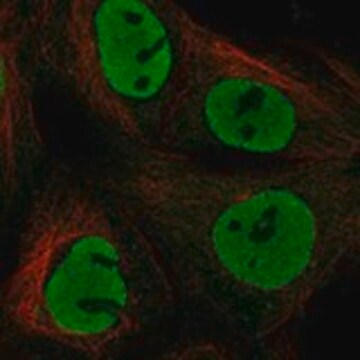MABS1274
Anti-GPx4 Antibody, clone 1B4
clone 1B4, from rat
Synonym(s):
Phospholipid hydroperoxide glutathione peroxidase, mitochondrial, GPx-4, GSHPx-4, mtPHGPx, PHGPx, Phospholipid hydroperoxide glutathione peroxidase, mitochondrial, snGPx, Sperm nuclei glutathione peroxidase
About This Item
Recommended Products
biological source
rat
Quality Level
antibody form
purified immunoglobulin
antibody product type
primary antibodies
clone
1B4, monoclonal
species reactivity
mouse
technique(s)
immunocytochemistry: suitable
immunohistochemistry: suitable
western blot: suitable
isotype
IgG1κ
NCBI accession no.
UniProt accession no.
shipped in
wet ice
target post-translational modification
unmodified
Gene Information
mouse ... Gpx4(625249)
General description
Specificity
Immunogen
Application
Signaling
Oxidative Stress
Western Blotting Analysis: A representative lot detected downregulated GPx-4 expression in kidney tissue extracts from tamoxifen/Tam-fed transgenic mice (CreERT2;Gpx4fl/fl) that express Cre-ERT2 and have both Gpx4 alleles flanked by loxP sites (Friedmann Angeli, J.P., et al. (2014). Nat. Cell Biol.16(12):1180-1191).
Western Blotting Analysis: A representative lot detected downregulated GPx-4 expression upon hydroxytamoxifen/Tam treatment of lung fibroblasts derived from transgenic mice (CreERT2;Gpx4fl/fl) that express Cre-ERT2 and have both Gpx4 alleles flanked by loxP sites (Friedmann Angeli, J.P., et al. (2014). Nat. Cell Biol.16(12):1180-1191).
Western Blotting Analysis: A representative lot detected high GPx-4 expression in both primary (HRPEitC) and transformed (HK-2) human tubular epithelial kidney cells (Friedmann Angeli, J.P., et al. (2014). Nat. Cell Biol.16(12):1180-1191).
Immunohistochemistry Analysis: A representative lot detected GPx-4 expression in paraformaldehyde-fixed, paraffin-embedded mouse testis sections (Courtesy of Dr. Marcus Conrad, Helmholtz Zentrum München, Germany).
Immunohistochemistry Analysis: A representative lot detected downregulated GPx-4 expression in paraformaldehyde-fixed, paraffin-embedded testis sections from GPx-4-knockout mice when compared to wild-type controls (Schneider, M., et al. (2009). FASEB J. 23(9):3233-3242).
Immunocytochemistry Analysis: A representative lot detected downregulated GPx-4 expression in paraformaldehyde-fixed, Triton X-100-permeablized epididymal spermatozoa from Gpx4-knockout mice when compared to wild-type controls by fluorescent immunocytochemistry (Schneider, M., et al. (2009). FASEB J. 23(9):3233-3242).
Quality
Immunocytochemistry Analysis: 4.0 µg/mL of this antibody detected GPx-4 in MEF1 cells.
Target description
Physical form
Storage and Stability
Other Notes
Disclaimer
Not finding the right product?
Try our Product Selector Tool.
Storage Class Code
12 - Non Combustible Liquids
WGK
WGK 1
Flash Point(F)
Not applicable
Flash Point(C)
Not applicable
Certificates of Analysis (COA)
Search for Certificates of Analysis (COA) by entering the products Lot/Batch Number. Lot and Batch Numbers can be found on a product’s label following the words ‘Lot’ or ‘Batch’.
Already Own This Product?
Find documentation for the products that you have recently purchased in the Document Library.
Our team of scientists has experience in all areas of research including Life Science, Material Science, Chemical Synthesis, Chromatography, Analytical and many others.
Contact Technical Service








